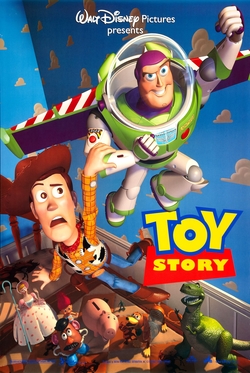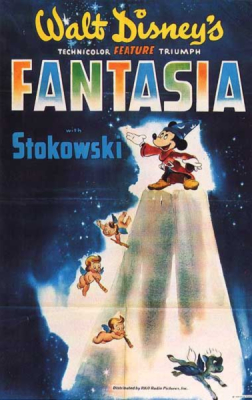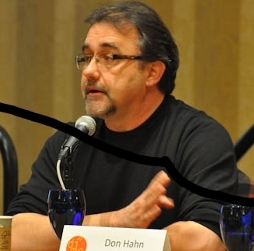Related Research Articles

Animation is a filmmaking technique by which still images are manipulated to create moving images. In traditional animation, images are drawn or painted by hand on transparent celluloid sheets (cels) to be photographed and exhibited on film. Animation has been recognized as an artistic medium, specifically within the entertainment industry. Many animations are computer animations made with computer-generated imagery (CGI). Stop motion animation, in particular claymation, has continued to exist alongside these other forms.

Timothy Walter Burton is an American director, producer, writer, and animator. Known for pioneering goth culture in the American film industry, Burton is famous for his gothic horror and fantasy films. He has received numerous accolades including an Emmy Award, and a Golden Globe Award as well as nominations for two Academy Awards and three BAFTA Awards. He was honored with the Venice International Film Festival's Golden Lion for Lifetime Achievement in 2007 and was given the Order of the Arts and Letters by Culture Minister of France in 2010.

Walter Elias Disney was an American animator, film producer, and entrepreneur. A pioneer of the American animation industry, he introduced several developments in the production of cartoons. As a film producer, he holds the record for most Academy Awards earned and nominations by an individual. He was presented with two Golden Globe Special Achievement Awards and an Emmy Award, among other honors. Several of his films are included in the National Film Registry by the Library of Congress and have also been named as some of the greatest films ever by the American Film Institute.

Toy Story is a 1995 American animated comedy film produced by Pixar Animation Studios for Walt Disney Pictures. The first installment in the franchise of the same name, it was the first entirely computer-animated feature film, as well as the first feature film from Pixar. It was directed by John Lasseter and produced by Bonnie Arnold and Ralph Guggenheim, from a screenplay written by Joss Whedon, Andrew Stanton, Joel Cohen, and Alec Sokolow and a story by Lasseter, Stanton, Pete Docter, and Joe Ranft. The film features music by Randy Newman, and was executive-produced by Steve Jobs and Edwin Catmull. The film features the voices of Tom Hanks, Tim Allen, Don Rickles, Jim Varney, Wallace Shawn, John Ratzenberger, Annie Potts, R. Lee Ermey, John Morris, Laurie Metcalf, and Erik von Detten.

Fantasia is a 1940 American animated musical anthology film produced by Walt Disney Productions, with story direction by Joe Grant and Dick Huemer and production supervision by Walt Disney and Ben Sharpsteen. It consists of eight animated segments set to pieces of classical music conducted by Leopold Stokowski, seven of which are performed by the Philadelphia Orchestra. Music critic and composer Deems Taylor acts as the film's Master of Ceremonies who introduces each segment in live action.

Dame Julie Andrews is an English actress, singer, and author. She has garnered numerous accolades throughout her career spanning over seven decades, including an Academy Award, a BAFTA Award, two Emmy Awards, three Grammy Awards, and six Golden Globe Awards as well as nominations for three Tony Awards. One of the biggest box office draws of the 1960s, Andrews has been honoured with the Kennedy Center Honors in 2001, the Screen Actors Guild Life Achievement Award in 2007, and the AFI Life Achievement Award in 2022. She was made a Dame (DBE) by Queen Elizabeth II in 2000.
While the history of animation began much earlier, this article is concerned with the development of the medium after the emergence of celluloid film in 1888, as produced for theatrical screenings, television and (non-interactive) home entertainment.

Toy Story 2 is a 1999 American animated adventure comedy film produced by Pixar Animation Studios for Walt Disney Pictures. The second installment in the Toy Story franchise and the sequel to Toy Story (1995), it was directed by John Lasseter, co-directed by Ash Brannon and Lee Unkrich, and produced by Helene Plotkin and Karen Robert Jackson, from a screenplay written by Andrew Stanton, Rita Hsiao, Doug Chamberlin, and Chris Webb, and a story conceived by Lasseter, Stanton, Brannon, and Pete Docter. In the film, Woody is stolen by a toy collector, prompting Buzz Lightyear and his friends to rescue him, but Woody is then tempted by the idea of immortality in a museum. Tom Hanks, Tim Allen, Don Rickles, Jim Varney, Wallace Shawn, John Ratzenberger, Annie Potts, R. Lee Ermey, John Morris, and Laurie Metcalf reprise their roles from the first Toy Story film and they are joined by Joan Cusack, Kelsey Grammer, Estelle Harris, Wayne Knight, and Jodi Benson, who play the new characters introduced in this film. This is the last Toy Story film to feature Varney as the voice of Slinky Dog before his death the following year.

The Hunchback of Notre Dame is a 1996 American animated musical drama film produced by Walt Disney Feature Animation and released by Walt Disney Pictures. It is loosely based on the 1831 novel of the same name by Victor Hugo. The film was directed by Gary Trousdale and Kirk Wise and produced by Don Hahn, from a screenplay written by Tab Murphy, Irene Mecchi, Jonathan Roberts, and the writing team of Bob Tzudiker and Noni White. Featuring the voices of Tom Hulce, Demi Moore, Tony Jay, and Kevin Kline, the film follows Quasimodo, the deformed and confined bell-ringer of Notre Dame, and his yearning to explore the outside world and be accepted by society, against the wishes of his cruel, puritanical foster father Claude Frollo, who also wants to exterminate Paris' Roma population.
Walt Disney Records is an American record label of the Disney Music Group. The label releases soundtrack albums from The Walt Disney Company's motion picture studios, television series, theme parks, and traditional studio albums produced by its roster of pop, teen pop, and country artists.

An American Tail is a 1986 American animated musical adventure film directed by Don Bluth and written by Judy Freudberg and Tony Geiss from a story by David Kirschner, Freudberg and Geiss. The film stars the voices of Phillip Glasser, John Finnegan, Amy Green, Nehemiah Persoff, Dom DeLuise, and Christopher Plummer. It is the story of Fievel Mousekewitz and his family as they emigrate from Russia to the United States for freedom, but Fievel gets lost and must find a way to reunite with them.

Walt Disney Animation Studios (WDAS), sometimes shortened to Disney Animation, is an American animation studio that creates animated features and short films for The Walt Disney Company. The studio's current production logo features a scene from its first synchronized sound cartoon, Steamboat Willie (1928). Founded on October 16, 1923, by brothers Walt Disney and Roy O. Disney, it is the oldest-running animation studio in the world. It is currently organized as a division of Walt Disney Studios and is headquartered at the Roy E. Disney Animation Building at the Walt Disney Studios lot in Burbank, California. Since its foundation, the studio has produced 62 feature films, from Snow White and the Seven Dwarfs (1937) to Wish (2023), and hundreds of short films.

The Swan Princess is a 1994 American animated musical fantasy film based on the ballet Swan Lake. Featuring Michelle Nicastro, Howard McGillin, Jack Palance, John Cleese, Steven Wright, Sandy Duncan, and Steve Vinovich, the film is directed by former Disney animation director Richard Rich and scored by Lex de Azevedo. The film was distributed by New Line Cinema in the United States and by Columbia TriStar Film Distributors International outside the US. It was released theatrically on November 18, 1994, and grossed $9.8 million against a $21 million budget, becoming a box-office bomb, partly due to struggling competition with a re-release of The Lion King (1994). The film later became popular through home video releases and has since been followed by a series of direct-to-video sequels starting in 1997.

Donald Paul Hahn is an American film producer who is credited with producing some of the most successful animated films in recent history, including Disney’s Beauty and the Beast and The Lion King.
David Maxwell Kirschner is an American film and television producer and screenwriter. His producing credits include Don Bluth's An American Tail and Titan A.E. animated features as well as the Child's Play horror film series.
United Kingdom Animation began at the very origins of the art form in the late 19th century. British animation has been strengthened by an influx of émigrés to the UK; renowned animators such as Lotte Reiniger (Germany), John Halas (Hungary), George Dunning and Richard Williams (Canada), Terry Gilliam and Tim Burton have all worked in the UK at various stages of their careers. Notable full-length animated features to be produced in the UK include Animal Farm (1954), Yellow Submarine (1968), Watership Down (1978), and Wallace & Gromit: The Curse of the Were-Rabbit (2005).

The Disney Renaissance was a period from 1989 to 1999 during which Walt Disney Feature Animation returned to producing critically and commercially successful animated films. These were mostly musical adaptations of well-known stories, similar to the films produced during the era of Walt Disney from the 1930s to 1960s. The resurgence allowed Disney's animated films to become a powerhouse of successes at the domestic and foreign box office, earning much greater profits than most of the Disney films of previous eras.
Tarzan was a Disney media franchise that commenced in 1999 with the theatrical release of the film Tarzan, based on the character Tarzan by Edgar Rice Burroughs.

Mary Poppins Returns is a 2018 American musical fantasy film directed by Rob Marshall, with a screenplay written by David Magee and a story by Magee, Marshall, and John DeLuca. Loosely based on the book series Mary Poppins by P. L. Travers, the film is a sequel to the 1964 film Mary Poppins, and stars Emily Blunt as Mary Poppins, with supporting roles from Lin-Manuel Miranda, Ben Whishaw, Emily Mortimer, Julie Walters, Dick Van Dyke, Angela Lansbury, Colin Firth, Meryl Streep, and David Warner in his final film appearance. Set in London during the Great Depression, the film sees Mary Poppins, the former nanny of Jane and Michael Banks, return to them in the wake of the death of Michael's wife.
References
- Bazalgette, Cary (1995). "Unshrinking the kids: Children's Cinema and the Family Film". In front of the children: screen entertainment and young audiences. British Film Institute. ISBN 9780851704524.
- Brown, Noel (2012). The Hollywood Family Film: A History, from Shirley Temple to Harry Potter . Cinema and Society. London: I.B. Tauris. ISBN 978-1780762708.
- Brown, Noel (2017). The Children's Film: Genre, Nation and Narrative. New York: Columbia University Press. ISBN 0231182694.
- Brown, Noel; Babington, Bruce (2015). Family Films in Global Cinema: The World Beyond Disney. Cinema and Society. London: I.B. Tauris. ISBN 978-1784530082.
- Wojcik-Andrews, Ian (2000). Children's films: history, ideology, pedagogy, theory. Garland reference library of the humanities ; Children's literature and culture. New York: Garland Pub. ISBN 978-0815330745.